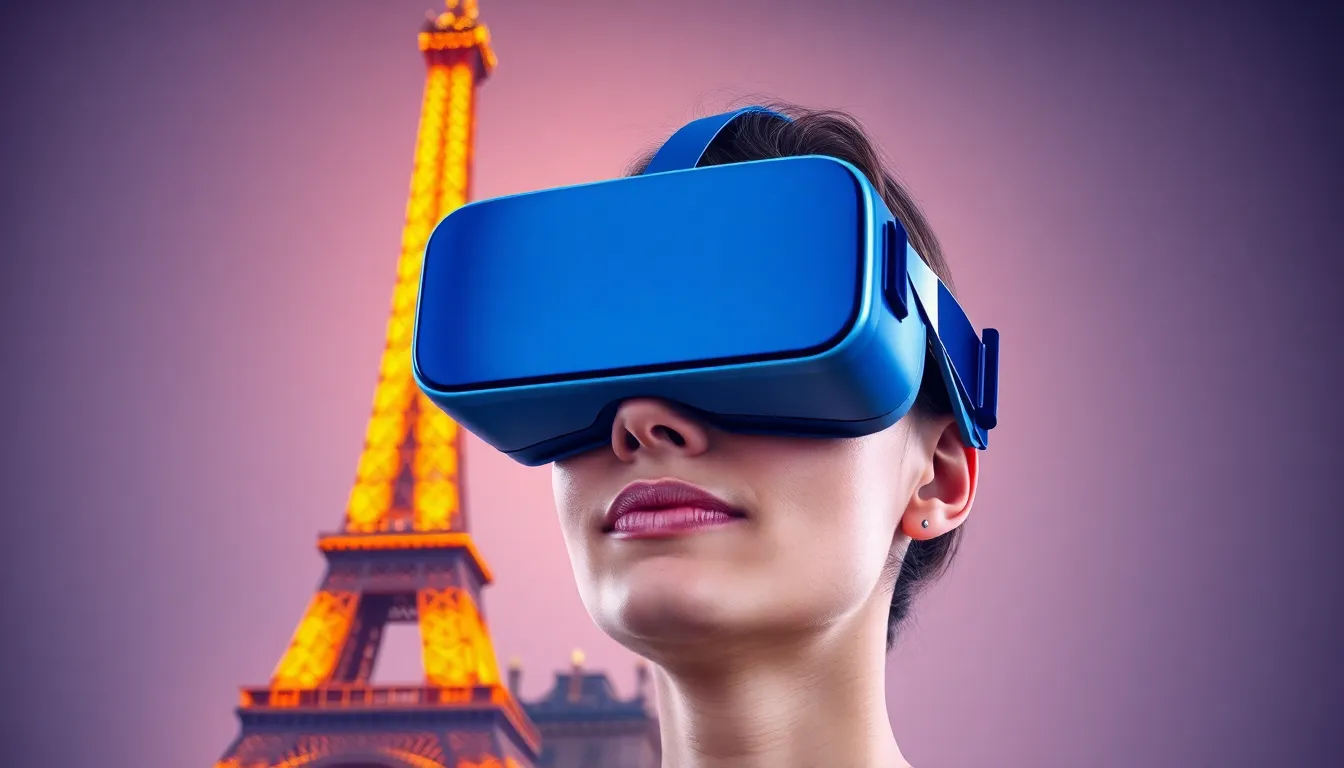In a world where wanderlust often collides with reality, virtual travel experiences have become the ultimate passport to adventure. Why fight over a middle seat or endure a layover when you can explore the streets of Paris or the beaches of Bali from the comfort of your couch? With just a click, anyone can embark on a journey that’s as close to teleportation as we’ve ever gotten—minus the jet lag and questionable airplane food.
Table of Contents
ToggleUnderstanding Virtual Travel Experiences
Virtual travel experiences involve exploring global destinations from home, combining technology and imagination to create enriching adventures. This format allows individuals to engage with various cultures and landscapes without physical travel.
Definition and Overview
Virtual travel experiences encompass digital tours, immersive videos, and interactive apps. These platforms let users navigate famous landmarks, discover local cuisines, or attend live events online. Through high-resolution graphics and 360-degree views, they create a realistic sensation of being present in a chosen location. Such experiences cater to diverse interests, from art to nature, ensuring something for everyone.
History and Evolution
The concept of virtual travel traces back to the early internet, when static images and text provided glimpses of distant places. As technology advanced, video content enhanced the experience by adding sound and motion. The introduction of virtual reality brought immersive experiences, allowing participants to feel more engaged. Today, platforms like Google Earth and dedicated travel apps continue to evolve, incorporating augmented reality and artificial intelligence. These innovations contribute to an ever-growing field, enabling people to travel in ways previously unimagined.
Types of Virtual Travel Experiences

Virtual travel experiences encompass a diverse range of options, utilizing technology to bring destinations closer to users. Two prominent categories include immersive technology and popular virtual destinations.
Immersive Technology in Travel
Immersive technology transforms the travel experience by simulating real-world environments. Virtual reality headsets allow users to virtually walk through landmarks and museums, providing a sense of presence. Augmented reality enhances physical spaces by overlaying digital information, enriching interactions with cultural sites. Interactive apps enable users to engage with videos and 360-degree views, fostering a deeper connection to surroundings. Innovations from tech companies also contribute to a more realistic exploration of destinations through high-resolution imagery. Engaging with these technologies can evoke emotions similar to actual travel experiences.
Popular Virtual Travel Destinations
Many destinations attract virtual travelers eager to explore from home. Paris captivates viewers with its iconic Eiffel Tower, while Rome showcases its ancient history through immersive tours of the Colosseum. Bali charms with its stunning beaches, offering virtual relaxation through picturesque landscapes. Japan’s cherry blossoms draw in visitors seeking seasonal beauty while exploring cultural heritage sites. National parks like Yellowstone provide glimpses of stunning natural scenery, promoting environmental awareness. Each destination offers unique experiences, allowing individuals to discover the world without the constraints of traditional travel.
Benefits of Virtual Travel Experiences
Virtual travel experiences offer numerous advantages, particularly in accessibility and cost savings. These benefits enhance the appeal of exploring the world from home.
Accessibility and Inclusion
Accessing global destinations becomes easier with virtual travel. Individuals with mobility challenges or health issues can experience cultural sites without physical barriers. Families can explore together, regardless of their travel flexibility. Many platforms provide multilingual options, making content available to a broader audience. Additionally, time constraints no longer limit travelers; engaging in virtual tours fits into busy schedules conveniently. Those in remote areas benefit from having the world’s wonders at their fingertips, fostering a sense of connection and opportunity.
Cost-Effectiveness
Travel expenses often add up quickly with traditional journeys. Virtual travel significantly reduces costs. Users avoid airfare, accommodations, and other travel-related fees. Many virtual experiences offer free options, while others charge minimal fees, making exploration financially feasible. Budget-conscious travelers can sample various destinations without breaking the bank. Additionally, enjoying a meal at home while touring famous culinary hotspots eliminates restaurant costs. With endless choices, travelers can curate their experiences according to their preferences and budgets, ensuring that virtual travel remains an attractive alternative.
Limitations of Virtual Travel Experiences
Virtual travel experiences offer exciting opportunities but also have notable limitations. Users miss out on the genuine atmosphere found in physical travel settings.
Lack of Physical Interaction
Physical interaction plays a crucial role in travel, enhancing experiences through direct contact with people and cultures. Virtual formats cannot replicate this essential human connection. Local interactions in markets, street festivals, or casual conversations typically occur face-to-face and remain absent in digital environments. Authentic cuisine tasting at local eateries often provides a sensory experience that virtual food tours cannot match. The vibrancy of physical travel fosters deeper emotional experiences, creating lasting memories that virtual platforms struggle to deliver. Without physical presence, travelers often feel disconnected from the destination’s true essence.
Technology Dependence
Virtual travel relies heavily on technology, which creates barriers for some individuals. Users must possess suitable devices and strong internet connections to access digital tours and experiences. Connectivity issues can lead to interruptions, detracting from the overall enjoyment. Learning curves associated with navigating new software may frustrate those unfamiliar with travel apps or virtual reality systems. Accessibility challenges arise for older adults or people less comfortable with technology, thereby limiting participation. Virtual adventures depend on technology’s evolution, leaving behind those unable to keep pace with rapid advancements.
Future of Virtual Travel Experiences
The future of virtual travel experiences looks promising as technology continues to advance rapidly. Innovations in immersive tech are reshaping how individuals explore the world. High-definition 360-degree videos and enhanced virtual reality capabilities immerse users like never before. Companies are also integrating artificial intelligence to tailor experiences based on user preferences. Increased availability of augmented reality apps allows travelers to interact more intimately with destinations. Virtual reality headsets are becoming more affordable, making these adventures accessible to a broader audience. With changing consumer preferences, virtual travel may become a staple in leisure and education sectors.
Trends and Innovations
Emerging trends significantly influence virtual travel experiences. Data shows that the popularity of live-streamed tours skyrocketed in the wake of the pandemic, drawing in millions of viewers. User engagement is heightened through interactive elements like real-time Q&A sessions and live guides. Collaborative experiences are becoming common, where friends can explore destinations together, despite being miles apart. Gamification elements add excitement, encouraging users to complete challenges and earn rewards. Furthermore, partnerships between technology companies and travel organizations make the future of virtual travel even more dynamic.
Impact on Conventional Travel
Conventional travel experiences are already feeling the effects of the rise of virtual travel. A notable trend shows some people opting for virtual tours instead of physical trips, leading to a decline in demand for certain destinations. Environmental consciousness is trending, with many travelers choosing virtual options to reduce their carbon footprints. As immersive virtual experiences become mainstream, it’s likely that some will prefer the comfort of home over long flights. However, this shift doesn’t entirely overshadow conventional travel; it complements and sometimes enhances it by providing new ways to engage with faraway places. Ultimately, a hybrid model of travel may emerge where experiences are enriched by both physical and virtual elements.
Virtual travel experiences are revolutionizing how people explore the world. They offer an innovative way to connect with diverse cultures and breathtaking landscapes without the usual travel hassles. As technology advances, these experiences will only become more immersive and engaging.
While they can’t fully replace the emotional depth of physical travel, virtual adventures serve as a valuable complement. They provide accessibility and affordability, making exploration possible for those who may face barriers in traditional travel.
The future of virtual travel looks bright with emerging trends and advancements that promise to enhance user experiences. As individuals seek new ways to satisfy their wanderlust, virtual travel will continue to carve its niche in the ever-evolving landscape of exploration.






